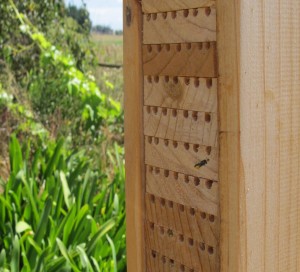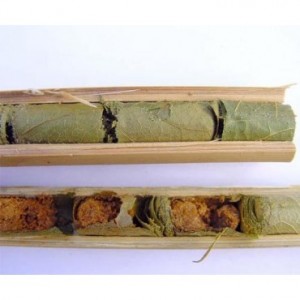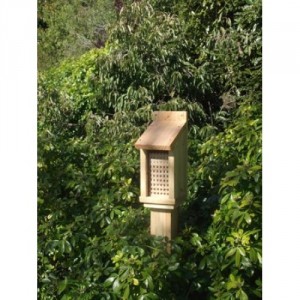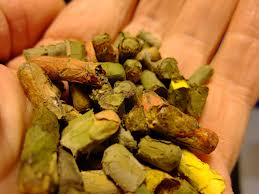Category Archives: Bees
Solitary bees in our own backyards?
Solitary bees in our own backyards?
What’s that green bee flying past? my wife asked
We were enjoying a coffee on the patio and sure enough a few minutes later a bee carrying a rolled up leaf rolled between its legs landed nearby. I had never seen a leafcutter bee before and I had certainly never heard of solitary bees that don’t live in hives.
Since that day www.creativewoodcraft.co.nz has been involved with educating and encouraging solitary bees in our own backyards!
As the name suggests, the female leafcutter bee cuts neat circles or ovals out of soft leaves such as roses. Rolling the leaf between her legs she then flies to a hole where she makes a craddle for her eggs. She stocks the cradle with small amounts of honey and pollen for the hatching lava. Once the nest is complete, the leafcutter bee looks for a new hole and starts a new nest.
These fasinating bees are tiny 4mm about half the size of a common house fly. The leafcutter bee does not defend her nest, so children can safely stand near a solitary bee house and observe the bees returning to their nests carrying leaf pieces and also large balls of orange pollen on their legs.
If your interested in beekeeping consider buying a solitary bee hive and a starter set of leafcutter bee cells from www.creativewoodcraft.co.nz
Encouraging the leafcutter bee and other solitary bees are fascinating to observe and play a vital role in pollinating our home gardens, fruit trees and vegetable gardens!
Please encourage and welcome these important pollinators to your backyard.
Order your solitary bee house and leafcutter bee cells today and have your pollinators ready for the warmer weather.
Creative Woodcraft is New Zealand’s only supplier of leafcutter bee cells to the home gardener.
New Zealand’s Only Supplier of Leafcutter Bee Cells to the Home Gardener!
Creative Woodcraft is a family run New Zealand business hand-crafting beautiful wildlife habitat, bird feeders and nesting boxes and other great garden products!
Creative Woodcraft is passionate about the future of bees in New Zealand and has teamed up with NZ pollination expert Dr Barry Donovan, of Donovan Scientific Insect Research in Lincoln, who has more than 50 years’ experience in the industry.
There is currently a great deal of attention focused on the future protection of honey bees throughout New Zealand, and quite rightly so. However let us not forget about the many other equally important pollinators out there, such as bumble bee’s and the numerous species of native solitary bee’s, which provide a huge impact on the success of our fruit and vegetables gardens, increasing pollination and in turn providing us with much greater yields.
Creative Woodcraft offers a proven solution to help gardener’s encourage native bees and help them to pollinate in their own backyard. At Creative Woodcraft you can purchase a solitary bee house and Leafcutter Bee Cells and have your pollinators ready for the warmer weather!
Pollinator friendly gardening
Whether pollinator-friendly gardening sounds daunting or adventurous, it is in reality quite a simple and do-able task. By making an urban garden, regardless of its size, a welcoming place for insects and animals, you are helping to preserve essential pollinators, which in turn will help to make any garden thrive. The urban environment is not always best suited to pollinators, but by providing suitable nesting habitat and planting a garden focused on supplying their needs is one step in the right direction.
Why are pollinators essential to an urban garden?
You may not always be able to observe pollinators in a garden, yard, or green space, but they are constantly present, and are actually working to your advantage. Not only are pollinators, such as bees, wasps, flies, beetles, butterflies, moths, bats an important part of the natural environment, but they also benefit us by their services to plants. As a group they pollinate fruits, vegetables, and flowers, both wild and domesticated, making plants healthier and more likely to produce a better quality harvest. The presence of pollinators in the urban garden can only be positive. Some solitary bees, for example nest in the ground, other types nest in holes in wood or trees, in an urban environment where suitable nesting habitat is scarce or in decline the use of solitary bee houses will greatly assist our pollinators.
Worldwide evidence shows that pollinator populations are declining, especially that of the honeybee. Not all the particular reasons are known, because the decline could be due to many factors, including the destruction of habitat. By creating attractive environments for pollinators in an urban setting you can provide essential habitats for these insects and birds. Habitats may not be widely available in a setting such as a new subdivision, unless otherwise provided or helped to develop. Pollinators, such as bumble bees and butterflies, are also very interesting to observe, and when you foster a pleasant pollinator-friendly garden you can experience a piece of pure, wild nature in your own backyard.
At creative wood craft we offer a wide range of habitat and products to assist our native pollinators in an urban environment.
Bumblebees are about 50 times more effective as pollinators than honeybees
Bumblebees and pollination 21 Jun, 2012 Plant & Food Research is investigating whether bumblebees can be used to pollinate flowers in commercial orchards.
Much of the food we eat every day relies on honey bees to pollinate the flowers. Honey bees have traditionally been used for pollination, mainly because they also produce honey. However, varroa mite has had an impact on hive productivity in New Zealand, and the mites have also developed resistance to two of the three chemicals used to control them. This makes using honey bees more expensive.
Scientists from Plant & Food Research wonder if growers could also use bumblebees to pollinate flowers in commercial orchards. Bumblebees are effective pollinators Bumblebees are about 50 times more effective as pollinators than honeybees, mainly because they are larger, so they pick up more pollen on their bodies. They are also better at crossing between the polliniser and the main cultivar so they are more effective for cross-pollination.
Research hopes bumblebees may offer growers second pollination option Plant & Food Research scientists are starting a bumblebee research programme. The aim is not to replace honey bees but to provide growers with a second option for pollination. There are two components to the research: Radio-tracking wild bumblebee queens in avocado orchards to find out what kinds of nests they prefer. Building and installing artificial hives that scientists hope will attract bumblebee colonies and provide a way of allowing growers to monitor bumblebee numbers on their properties. Dr David Pattemore from Plant & Food Research.
Increase our Native Bee Population
Calling all Gardeners! Help Pollination and Increase our Native Bee Population.
Lets increase pollination and increase our native bee population in our own back yards. Bumble bee nesting boxes and solitary bee houses can help increase pollination.
Passionate about the future of bees in New Zealand, Ian Morton from Creative Woodcraft has teamed up with a pollination expert to help Kiwi gardeners encourage native bees to pollinate their backyards.
Designed with the assistance of Dr Barry Donovan, of Donovan Scientific Insect Research in Lincoln, the company’s leaf cutter bee cells are expected to help increase the native bee population in New Zealand. “We have designed solitary bee hives and bumble bee nesting boxes that will encourage our native bees to nest in these sites,” says Ian. “By providing a suitable habitat, a growth in population will occur and positively benefit the number of pollinators out there”.
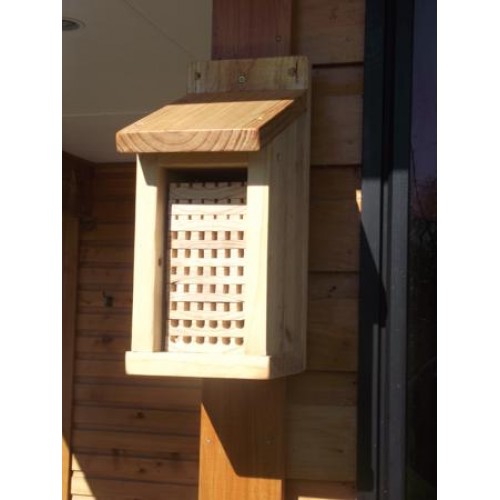
Creative Woodcraft’s solitary bee houses include a variety of nesting hole diameters, suitable for hosting up to six species of bees and three species of wasp.Click here for details about the Creative Woodcraft range, or to place an order.
Register with Creative Woodcraft online and receive free, downloadable e-book containing information about New Zealand native solitary bees, bumble bees and leaf cutter bees.
Leaf cutter Bee Cells

